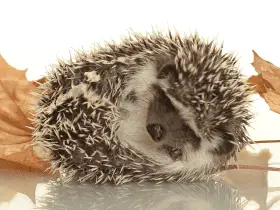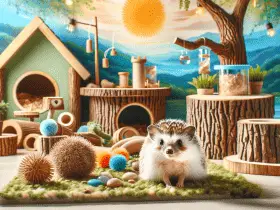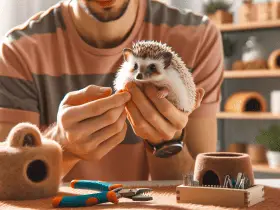Have you ever wondered why hedgehog quills are so unique? Well, we’ve delved into the science behind these fascinating spines to bring you all the answers.
In this article, we’ll explore the anatomy, evolutionary purpose, and structure of quills. We’ll also dive into how hedgehogs use their quills for defense and the intriguing growth and shedding cycle.
Plus, we’ll uncover the role of quills in thermoregulation and discuss their vibrant colors and patterns.
Join us on this journey as we unravel the secrets of hedgehog quills!
Key Takeaways
- Hedgehog quills are composed of keratin and have a hollow core, providing flexibility and protection.
- Quills have evolved through natural selection to serve as a defense mechanism against predators, making it difficult for them to attack or consume hedgehogs.
- Quills have sensory functions, acting as receptors that transmit information to the nervous system, and contribute to thermoregulation through their ability to expand or contract in response to environmental changes.
- The coloration, patterns, and genetic factors of quills have evolutionary purposes, such as camouflage and species recognition, and play a role in hedgehog defenses and overall health.
The Anatomy of Hedgehog Quills
Did you know that hedgehog quills have a hollow core? It’s true! These unique spines not only provide protection for the hedgehog, but they also play a crucial role in its growth and development. Understanding the anatomy of hedgehog quills can give us insights into their growth patterns and quill development.
Hedgehog quills are made up of keratin, the same protein found in our hair and nails. However, unlike our hair follicles, which grow continuously throughout our lives, hedgehog quills have a specific growth pattern. Research has shown that new quills emerge from specialized skin cells called follicular keratinocytes. These cells undergo rapid division and differentiation to form the hollow structure of the quill.
As the new quill grows, it pushes out older ones, causing them to fall out naturally. This process ensures that hedgehogs always have sharp and sturdy spines for protection. Additionally, this unique growth pattern allows for continuous regeneration of their quills as needed.
Understanding how hedgehog quills develop can help us appreciate their remarkable adaptation to their environment. The hollow core of these spines provides an efficient way for them to maintain flexibility while still offering ample protection against potential predators. So next time you see a hedgehog with its prickly coat, remember the fascinating science behind those hollow-core quills!
The Evolutionary Purpose of Quills
The evolutionary purpose of quills is to provide hedgehogs with a defense mechanism against predators. Quills are unique structures that have evolved over time through the process of natural selection, allowing hedgehogs to survive in their environments. Hedgehog quills are specialized hairs made up of keratin, the same protein found in our hair and nails. These spiky appendages serve as a deterrent to potential predators by making it difficult for them to attack or consume the hedgehog.
Through evolutionary adaptation, hedgehogs have developed quills that are sharp, pointy, and easily erectable when threatened. This adaptation allows them to create a barrier around their bodies, protecting vulnerable areas from harm. The quills act as armor, deterring predators such as foxes, badgers, and birds from attacking.
Natural selection plays a crucial role in determining which individuals within a population possess advantageous traits like strong and effective quills. Hedgehogs with better-developed quills are more likely to survive and reproduce compared to those with weaker or less effective ones. Over time, this leads to an increase in the frequency of these beneficial traits within the population.
The Structure and Composition of Quills
Hedgehog quills are composed of keratin, which is the same protein found in our hair and nails. These quills play a crucial role in providing protection for hedgehogs against predators. The structure of these quills is quite fascinating. Each quill consists of a hollow shaft and multiple layers of overlapping scales, similar to the structure of a pinecone or an artichoke.
Quill growth is an ongoing process for hedgehogs. Just like our hair grows continuously, new quills emerge from the skin as old ones shed. This continuous growth ensures that the hedgehog always has a fresh set of sharp and sturdy defenses. Research suggests that factors such as nutrition and overall health can influence the rate of quill growth.
The unique structure of hedgehog quills allows them to effectively deter potential threats. When threatened, a hedgehog will curl up into a tight ball, with its spiky exterior acting as a formidable barrier against predators. The overlapping scales on each quill make it difficult for predators to penetrate through their defenses.
Understanding the composition and structure of hedgehog quills provides valuable insights into their protective mechanisms and evolutionary adaptations. These remarkable features not only help hedgehogs survive in their natural habitats but also inspire us to appreciate the wonders of nature’s design.
How Hedgehogs Use Their Quills for Defense
When threatened, hedgehogs curl up into a tight ball, using their spiky exterior as a formidable barrier against predators. This unique defense mechanism is made possible by the adaptations of their quills. Hedgehog quills are not only sharp and pointed, but they also have special features that enhance their protective capabilities.
One of the key quill defense mechanisms is their ability to detach from the hedgehog’s body when under attack. When a predator tries to grab or bite the hedgehog, these quills easily detach and stick into the attacker’s skin, causing discomfort and discouraging further pursuit. Additionally, hedgehog quills have a hollow core filled with air pockets that make them lightweight yet rigid enough to withstand pressure.
The structure of hedgehog quills plays an essential role in their protection. Each individual quill is composed of keratin, which is the same material found in human hair and nails. However, unlike our hair or nails, hedgehog quills have multiple layers that provide extra strength and flexibility.
Furthermore, recent research has shown that some species of hedgehogs can control their quill movements voluntarily. This means they can raise or lower their spines depending on the level of threat they perceive.
The Growth and Shedding Cycle of Quills
During the growth and shedding cycle of quills, you may notice changes in their appearance and feel as new ones emerge and old ones are replaced. Hedgehogs have a fascinating ability to regenerate their quills, which is known as the growth cycle. This process ensures that they always have a fresh set of spines for protection.
The shedding process begins when a hedgehog’s quills reach the end of their lifespan. The old quills gradually loosen from the skin and fall out, making room for new ones to grow. This shedding can occur several times throughout a hedgehog’s life, depending on various factors such as age, health, and environmental conditions.
As new quills start to grow, you might observe tiny bumps or stubs protruding from the skin. These are called ‘quill nubs’ or ‘quill sheaths.’ Over time, these nubs develop into fully grown quills with sharp tips and sturdy shafts.
It is important to note that during this growth cycle, hedgehogs may experience some discomfort or sensitivity in the areas where new quills are emerging. They may exhibit signs of itchiness or irritation as their body adjusts to the presence of developing spines.
Understanding the growth and shedding cycle of hedgehog quills provides insight into their unique physical adaptations. By continually replacing their quills through this natural process, hedgehogs ensure they remain well-equipped for defense while maintaining their distinctive appearance.
The Sensory Function of Quills
In our previous discussion, we explored the growth and shedding cycle of hedgehog quills. Now, let’s delve into another intriguing aspect of these unique spines: their sensory function.
Hedgehog quills not only serve as a protective barrier but also play a vital role in sensory perception. Each quill is equipped with specialized nerve endings that allow hedgehogs to gather information about their surroundings. These nerve endings are highly sensitive to touch, pressure, and even temperature changes.
When a hedgehog encounters an object or surface, the quills act as receptors, transmitting sensory information to the nervous system. This enables them to navigate their environment effectively and avoid potential threats.
Moreover, quill development is closely linked to this sensory function. As new quills grow in place of shed ones, they undergo a complex process that ensures optimal sensitivity. The growth and arrangement of nerve endings within each new quill contribute significantly to its ability to detect stimuli accurately.
Research suggests that the size and density of nerve endings vary across different regions of hedgehog bodies. For instance, the quills on their back possess more nerve endings compared to those on their belly or sides. This variation allows for enhanced sensing abilities in areas where protection is most crucial.
Understanding the intricate relationship between sensory perception and quill development sheds light on why these spines are so uniquely adapted for hedgehogs’ survival in diverse habitats.
The Role of Quills in Thermoregulation
To regulate our body temperature, hedgehog quills expand or contract in response to changes in the environment. This unique characteristic of hedgehogs allows them to maintain a stable internal temperature despite external fluctuations. The insulating properties of quills play a crucial role in this thermoregulatory process.
Hedgehog quills are made up of keratin, just like human hair and nails. However, they differ in structure and growth rate. Quills develop from specialized skin cells called follicles, which produce keratin at a rapid rate. As the quill grows, it hardens and becomes more rigid, providing protection against predators.
The hollow nature of hedgehog quills also contributes to their insulating properties. Air trapped within the quill acts as an extra layer of insulation, preventing heat loss from the body. Additionally, the outer layer of the quill is covered with a waxy substance that helps repel water and retain heat.
Quill development and growth rate vary among individual hedgehogs and species. Factors such as age, health, diet, and genetics can influence how quickly or slowly their quills grow. It is important to note that proper care and nutrition are essential for healthy quill development.
The Coloration and Patterns of Quills
When examining the coloration and patterns of quills, it’s important to consider the evolutionary purpose behind these characteristics.
Patterns on quills may serve as a form of camouflage or warning signals to predators.
Additionally, genetic factors play a significant role in determining the coloration of quills, with variations in genes influencing pigment production and distribution.
Understanding these aspects can provide insights into the adaptive nature of hedgehog defenses and shed light on their fascinating evolutionary history.
Evolutionary Purpose of Patterns
The unique patterns on hedgehog quills likely evolved for a specific purpose. These patterns are not just random designs; they serve as an evolutionary adaptation that has been shaped by natural selection over time. Here are five reasons why the patterns on hedgehog quills are so important:
- Protection: The intricate patterns provide camouflage, making it difficult for predators to spot them in their natural habitats.
- Communication: Hedgehogs use their quill patterns to communicate with each other, conveying information about their mood or readiness to mate.
- Warning signals: Certain quill patterns may act as warning signals to potential predators, indicating that the hedgehog is armed and ready to defend itself.
- Thermoregulation: The arrangement of quills helps regulate body temperature by creating pockets of air that insulate against extreme heat or cold.
- Species recognition: Each species of hedgehog has its own unique pattern, allowing individuals to recognize members of their own kind and avoid mating with unrelated individuals.
These adaptations highlight the remarkable ability of hedgehogs to survive and thrive in diverse environments.
Genetic Factors Influencing Coloration
Coloration of hedgehog quills is influenced by genetic factors, resulting in a wide range of vibrant patterns. Genetic mutations play a crucial role in determining the color and pattern variations observed in hedgehogs. These mutations affect the production and distribution of pigments within the quills, leading to unique coat patterns among individuals.
Research has shown that certain genes control pigment production, with different alleles responsible for specific colors or patterns. For example, a mutation in the MC1R gene can result in a shift from dark brown to blonde quills. Additionally, variations in other genes such as ASIP and MITF contribute to the diversity seen in hedgehog coats.
The Unique Properties of Quill Barbs
When discussing the unique properties of quill barbs, two key points to consider are their structural strength and their self-defense mechanisms.
The structural strength of quills is crucial in enabling them to withstand external forces and protect the hedgehog’s vulnerable skin.
Through our research, we will delve into the composition and arrangement of these barbs to understand how they provide a robust defense system for hedgehogs against potential threats.
Structural Strength of Quills
You might be wondering how hedgehog quills are able to withstand such strong forces without breaking. Well, it all comes down to the unique structure and durability of these quills. They are specifically designed to provide protection while maintaining flexibility.
Here’s why hedgehog quills are so remarkable:
- Layered composition: Each quill is made up of several layers, including a tough outer layer and a softer inner layer. This layered structure allows for both strength and resilience.
- Interlocking barbs: The quill is covered in tiny barbs that interlock with each other, creating a tightly woven network. This not only adds strength but also prevents the quills from easily dislodging.
- Keratin-rich material: Quills are composed of keratin, the same material found in human hair and nails. Keratin provides strength and durability, enabling the quills to withstand external pressures.
- Flexible base: The base of each quill is attached to specialized muscles that allow the hedgehog to control their movement. This flexibility gives the quills additional resistance against breakage.
- Natural shock absorption: Hedgehog spines have evolved to absorb shocks and distribute forces evenly across their surface area, minimizing damage during impacts.
Understanding the intricate structure and durability of hedgehog quills helps us appreciate nature’s ingenious designs that enable animals to thrive in challenging environments.
Self-Defense Mechanisms of Quills
The self-defense mechanisms of hedgehog quills are truly fascinating. These unique structures not only provide protection for the hedgehog but also play a crucial role in their survival. Hedgehog quills, made primarily of keratin, are specialized hairs that have evolved to become sharp and rigid.
When threatened, hedgehogs have the ability to erect their quills, creating an intimidating barrier against predators. But what happens when a quill is lost or damaged? Remarkably, hedgehogs have the ability to regenerate their quills through a process called quill growth.
New quills grow from specialized skin cells located at the base of each follicle. This remarkable regenerative ability ensures that hedgehogs can continuously replenish their defensive armor and remain protected in their environment.
The Relationship Between Quills and Hedgehog Health
Contrary to popular belief, hedgehog quills play a crucial role in their overall health and well-being. These unique spines not only serve as a form of self-defense but also contribute significantly to their physical and emotional health. Understanding the relationship between quills and hedgehog health is essential for providing proper care for these fascinating creatures.
- Quill growth: Hedgehog quills continuously grow throughout their lives, just like human hair or nails. This growth ensures that they always have a protective layer to shield them from potential harm.
- Quill shedding process: Shedding old or damaged quills is a natural part of a hedgehog’s life cycle. It allows new quills to grow in their place, maintaining the integrity of their defense mechanism.
- Temperature regulation: The hollow structure of hedgehog quills helps with temperature regulation by trapping air close to the skin during colder weather, keeping them warm and snug.
- Sensory perception: Quills are covered in nerve endings, allowing hedgehogs to sense changes in their environment. This heightened sensory perception helps them navigate their surroundings and detect potential threats.
- Emotional well-being: Proper quill care is crucial for a hedgehog’s emotional well-being. Regular grooming and attention help establish trust between pet owners and these adorable animals.
Frequently Asked Questions
Are Hedgehog Quills Painful to Touch or Handle?
Hedgehog quills can be painful to touch or handle due to their sharpness and ability to penetrate skin. Hedgehogs use their quills for defense by rolling into a ball, making it difficult for predators to attack.
Can Hedgehogs Control the Movement of Their Quills?
Yes, hedgehogs can control the movement of their quills. They have fascinating quill movement mechanics and intricate quill control mechanisms that allow them to adjust the position and angle of their quills for defense.
Do Hedgehogs Shed All of Their Quills at Once?
Hedgehogs shed their quills in a process influenced by factors like age, health, and environment. Shedding occurs gradually rather than all at once. Understanding the hedgehog quill shedding process can help us care for these unique creatures effectively.
Can Hedgehogs Regrow Quills if They Are Damaged or Lost?
Yes, hedgehogs can regrow quills if they are damaged or lost. Their regrowth capabilities rely on a unique quill regeneration process that allows them to replace quills and maintain their protective coat.
Are Hedgehog Quills Made of the Same Material as Other Animal Spines?
Hedgehog quills, unlike porcupine quills, are not made of the same material as other animal spines. Understanding the science behind quill development in hedgehogs is essential to uncovering their unique composition.
Conclusion
In conclusion, the science behind hedgehog quills is truly fascinating.
These spiky appendages serve as both a defensive mechanism and a tool for thermoregulation.
Their unique structure and composition make them strong yet flexible, allowing hedgehogs to protect themselves from predators while still being able to curl into a protective ball.
The growth and shedding cycle of quills ensures that they remain sharp and effective throughout the hedgehog’s life.
Like a suit of armor, these quills are not only functional but also contribute to the overall health and well-being of these adorable creatures.
















Leave a Reply
View Comments